10 Great Primary Books for Celebrating the Big Outdoors
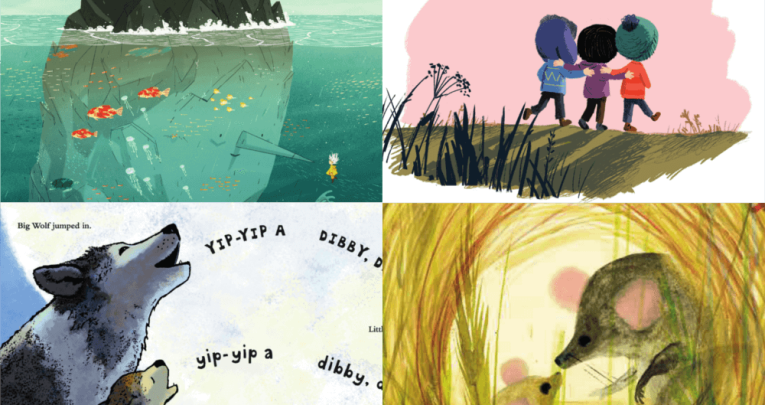
The natural world is a place of adventure and excitement, so step out of the front door and take your class into the great unknown with these fiction-inspired activities…

Foundation Stage
1 | On Sudden Hill
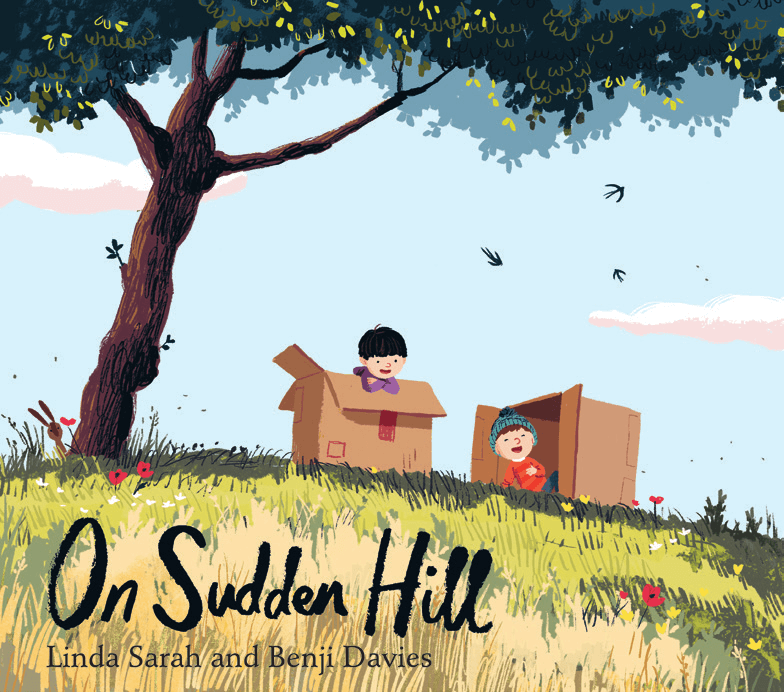
by Linda Sarah and Benji Davies
(Simon and Schuster)
What’s the story?
Birt and Etho like playing with cardboard boxes on Sudden Hill. Birt loves their ‘two-by-two rhythm’, so when another boy joins them, Birt feels left out.
Then Etho and Shu create a Monster Creature Box Thing just for Birt, and he realises that actually, ‘three-by-three’ can be best of all.
This gentle book celebrates imaginative play and puts boys’ friendships centre stage.
Thinking and talking
Have you ever felt left out or had friendship worries? What happened to make things better? What would you like to make from a cardboard box, and why?
Try this
- Collect some enormous boxes and use to make dens and imaginary vehicles. Play with them, then write and draw about your experiences.
- Look at the picture of Birt on the swing seat. How is he feeling? Now look at the picture of him at the end of the book. How’s he feeling now? What happened to change things? Pretend to be Birt and tell your story.
2 | There’s a Tiger in the Garden
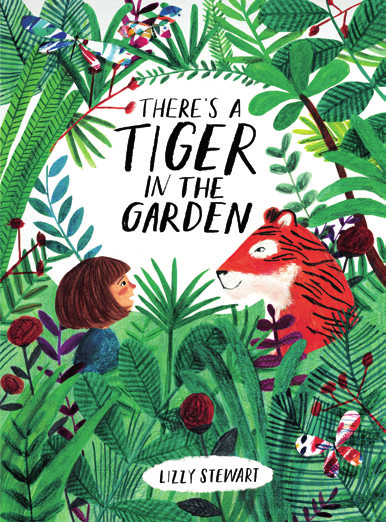
by Lizzy Stewart
(Macmillan)
What’s the story?
“Are you real?”
“I don’t know,” says the tiger.
“Are you?”
Nora thinks Grandma’s garden is boring and doesn’t believe a tiger lives out there. But when Nora starts exploring, she discovers all sorts of creatures – from bird-sized dragonflies to the tiger himself. And is that a mermaid in the bath?
Strikingly illustrated with a rich colour palette, this book offers subtle philosophical reflections alongside great storytelling.
Thinking and talking
Are there really tigers and polar bears in Grandma’s garden? What adventures have you had outside? If you could make something real by believing in it, what would it be?
Try this
- Plant props in a wood or garden (a tiny door on a tree trunk; a toy animal among the leaves…) then take children on a walk to discover them. Use your experiences to inspire storymaking and storytelling.
- Draw a large-scale map of Lizzy’s garden-journey and illustrate to create a whole-class artwork.
3 | Little Wolf’s First Howling
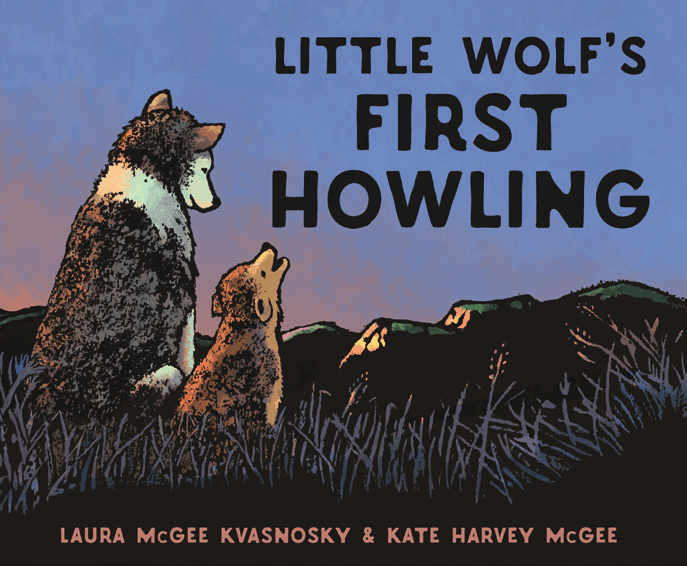
by Laura McGee Kvasnosky and Kate Harvey McGee
(Walker)
What’s the story?
“Ok, Son. Give it a try…”
Little Wolf’s dad is taking him for his first howling. Little Wolf wants to get it right, just like Dad, but can’t resist adding special touches of his own. It isn’t proper howling – but luckily for Little Wolf his dad finds the yip-yip-a-dibbydibby just as irresistible.
Set in the Yellowstone wilderness, this heartwarming tale about family relationships, ‘doing your own thing’ and the joy of music has been illustrated with bold graphic flair.
Thinking and talking
What have you learned from your dad, uncle or granddad? And what have they learned from you? If you lived in the wilderness, what would you do?
Try this
- Have a go at some ‘proper howling’, Big Wolf-style. Listen (and move!) to some jazz. Can you invent some jazzy Little-Wolf-style howling of your very own? Practise until everyone can howl wolf-music together.
- These story-wolves inhabit a well-researched landscape based on a real place. Look at each spread and talk about the elements you can see – mountains, cliffs, trees, rivers, grass, boulders… What would it feel like to walk through that landscape, do you think? What might you be able to hear, smell and taste? Collect words and ideas, then write a description.
4 | Stone Girl Bone Girl
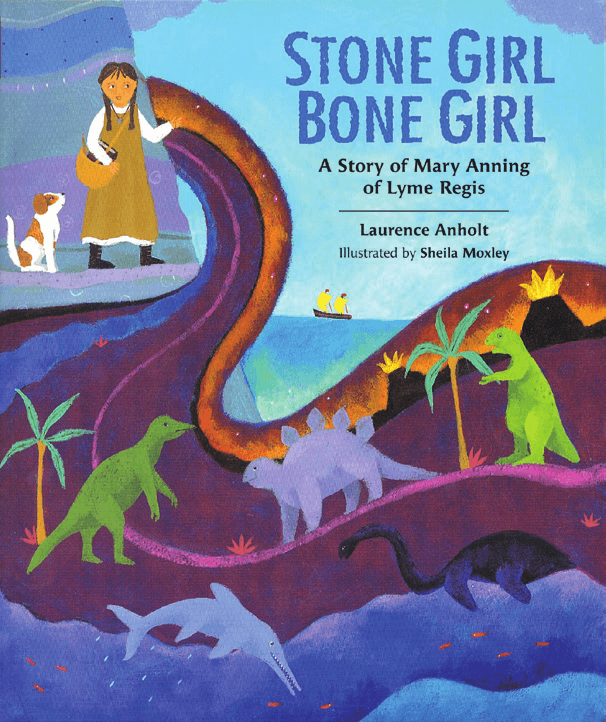
by Laurence Anholt, illustrated by Sheila Moxley
(Templar)
What’s the story?
“There was something hidden right inside the rock! ‘It’s TREASURE!’ she gasped.”
Mary Anning was a fossil collector who became famous aged 12 for discovering an ichthyosaur.
With plenty of ‘factional’ details and a strong narrative thread, this longer-text picturebook has a robust and intriguing heroine and can be used to introduce wider issues – such as Victorian expectations of women; and women in science (Mary’s contribution to Darwin’s Theory of Evolution is mentioned in an appendix).
Thinking and talking
What are fossils? Has anyone ever seen one? Why do you think Mary was so excited by them? What kind of work did girls usually do in Victorian times? What about boys?
Try this
- Create your own cabinet of curiosities with carefully labelled natural objects, pictures and further information. Go on a walk to collect more exhibits.
- Find out about rocks, fossils and prehistoric creatures and present what you’ve discovered to another class, or in an assembly for the whole school.
- Use commercially available play fossils to create a sensory experience. Allow children to explore the collection, then hide your fossils in sand. Blindfold children and ask them to find (and identify?) the fossils by touch. Or bury fossils outdoors and host an ‘archaeological dig’ using brushes and other small implements to remove soil from your finds.
Key Stage 1
5 | A First Book of Nature
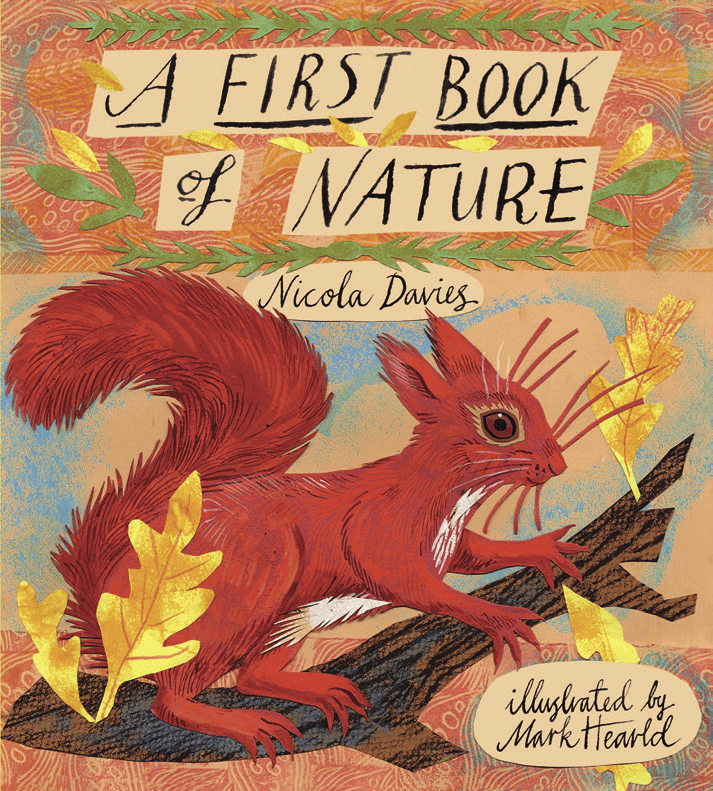
by Nicola Davies and Mark Hearld
(Walker)
What’s the story?
Part poetry anthology, part scrapbook, this book has been arranged by season.
With richly decorative spreads on subjects ranging from stargazing to beachcombing, it’s firmly rooted in children’s experiences of the natural world and will inspire many outdoor adventures.
Thinking and talking
Which spreads describe familiar animals, events and experiences, and which are new to you? Which illustration interests you most, and why?
Try this
- Use to mark the changing of the seasons in your book corner – dip in and out according to the date and/or weather!
- Have a go at some of the activities, then write about them: pond-dipping, den-building, compost-making, birdcake-making, seed-planting…
- Look at the patchwork pigeons and chickens on pages 52 and 94, then paint your own papers, cut into bird or feather shapes and use to construct your own collages, like Mark Hearld.
6 | The Road Home
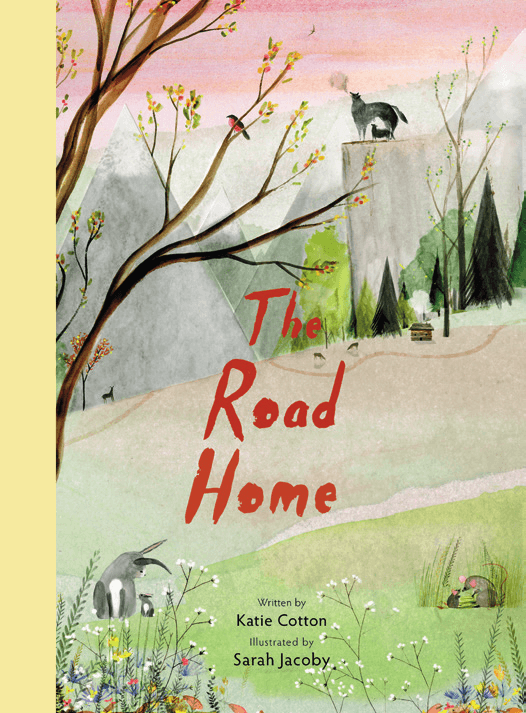
by Katie Cotton and Sarah Jacoby
(Frances Lincoln)
What’s the story?
“This road is hard, this road is long, this road that leads us home…”
This book tells a poetic tale of survival and love in the animal kingdom. Finely balanced between reality and sentiment, its illustrations have both cosiness and bite.
Here, hunger burns and cold chills throats – but the animals urging us to fly and hunt with them draw comfort from each other and their natural place.
Thinking and talking
What is this book telling you about animals and their lives? Talk about home and what it means across a range of contexts. Why does the author say “and so this road is home?”
Try this
- Look at the illustration of the field mouse nest. Investigate different media and ways of drawing similar nests and flowers. What happens if you use watercolour, pastels, coloured pencils, wax crayons, collage… or a mixture? Use your preferred techniques to create your own nests and flowers. Cut and stick on a large sheet of paper to create a whole-class artwork. Add some mice!
- Find out about different animal homes and create an illustrated report.
Key Stage 2
7 | The Secret of Black Rock
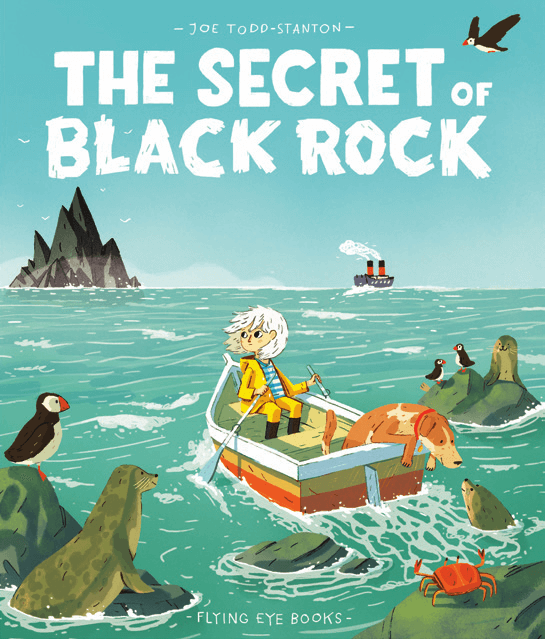
by Joe Todd Stanton
(Flying Eye Books)
What’s the story?
“Black Rock wasn’t a monster, but a home to all these amazing creatures…”
The sailors in Erin’s village are full of tales about Black Rock. But when Erin stows away on her mum’s fishing boat and comes face-to-face with him, she discovers he isn’t a rock at all – he’s an enormous living creature, and many smaller creatures depend on him for shelter.
Unfortunately, the adults in Erin’s village plan to destroy him! Can Erin stop them?
With more than a splash of classic Famous-Five adventure, together with environmental awareness and humour, this is a story that appeals to reluctant and confident readers alike.
Thinking and talking
Why do the adults want to destroy Black Rock? Why won’t they listen to Erin? What needs protecting in our oceans, and what are people doing about it?
Try this
- Look at the picture of Erin escaping from the house. If you didn’t know what was happening, what would it tell you? And what’s unusual about it? (Erin is shown four times in a single picture.) Try redrawing the action in this picture over four panels, each showing a single view of Erin, to make a comic strip. Now choose an action sequence of your own and draw it, first as a set of four panels, then as a single picture. Add some text!
- Choose a real-world geographical feature to research – mountain, island, waterfall… Now imagine it’s alive, just like Black Rock. Develop a character for your landscape-creature and write about it.
8 | Where my Wellies Take Me
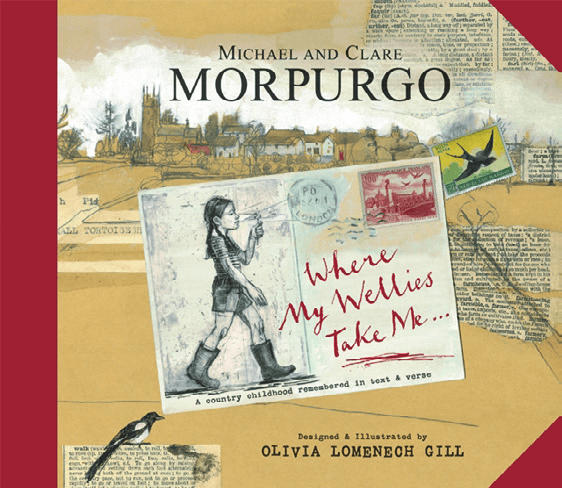
by Michael and Clare Morpurgo, illustrated by Olivia Lomenech Gill
(Templar)
What’s the story?
Pippa loves exploring the farm. She also loves poetry, and in this anthology there are plenty of country-themed poems to discover, both old and new.
Stunningly illustrated, this book includes numerous pull-out pages, maps and inserts.
Thinking and talking
Which double spread do you like best, and why? And which poem? What do you think of the way this book has been designed and produced?
Try this
- Let this book inspire your own class anthology. Go for an Explorers’ Walk, taking photographs and notes, making sketches and annotating maps as you go. Write new poems of your own, or choose existing poems. Collect printed ephemera linked to your route, such as tickets, leaflets, postcards and newspapers and use to create backdrops for your poetry and artwork.
- Tracing-paper inserts add an extra layer to some images (see horse and rider on pages 60-61, and flying kingfisher on pages 50-51). Can children use tracing paper to add extra layers to images they’ve found in a magazine, or drawn themselves?
9 | Journey to the River Sea
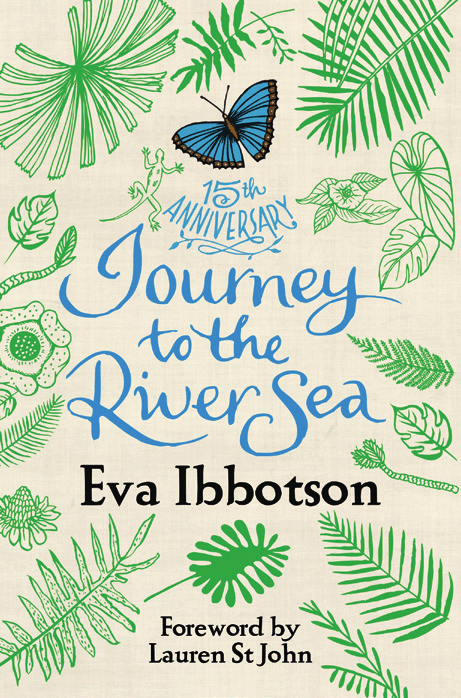
by Eva Ibbotson
(Macmillan)
What’s the story?
It’s 1910. Accompanied by the redoubtable Miss Minton, orphan Maia travels to the Amazon to live with her aunt and uncle, who spend all their time trying to keep the nasty jungle at bay.
But Maia and Miss Minton discover another side to the Amazon – and so begins one of the most memorable wilderness adventures of all.
Themes to explore include ecology, wildlife, conservation, exploration, specimen-collecting and Victorian history.
Thinking and talking
Which characters enjoy the natural world of the Amazon, and which don’t? What do their attitudes tell us about their personalities, do you think? Who and what changes during this story? How, and why?
Try this
- Use the text to create two sets of quotes: positive things about living in the Amazon (its beauty, diversity and freedom – as expressed by Miss Minton, Finn and Maia) and negative (how unpleasant and ‘different’ it is – as expressed by the Carters, Clovis and the investigators). Discuss, then research the Amazon and its wildlife to find out more. Use to create written reports and presentations. Why do we need to conserve and protect wild places like the Amazon?
- Visit a museum with a collection of specimens such as beetles or butterflies. Sketch and photograph individual animals or insects and use to make accurate scientific illustrations to display in Victorian-style cases back in school. Research your specimens and write informative labels. Find out about the explorations and discoveries of Victorian naturalists.
10 | Du Iz Tak?
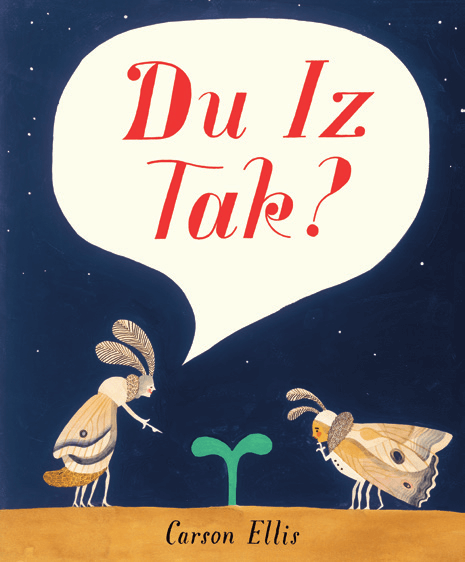
by Carson Ellis
(Walker)
What’s the story?
“Du Iz Tak?” asks an insect, looking at a seedling. “What is that?”
The seedling grows into a plant, and the insects build a tiny play-fort in its branches. The plant flowers – unk scrivadelly gladdenboot – and a spider arrives to menace everyone.
And so it goes on… will anything survive?
Gently and with great originality, this book explores the cycle of life from an insect’s perspective. Written in an invented ‘bug language’ but accessible to any curious reader with an open mind, it’s a pleasure to share with older children as well as younger ones.
Thinking and talking
What did you think about the bug language? What helped you understand it? Why doesn’t the bug on the last page recognise the new seedling? Does anyone in your class speak more than one language? Find lots of ways of asking du iz tak? – and lots of answers!
Try this
- Invent names and back-histories for the characters in this book, then tell some of their stories using a first-person perspective. Remember – there’s more than one story in this book. Look carefully at the twig and the cocoon!
- When you don’t understand a language, facial expressions, tone and context can help you make sense of it. Discuss, then practise reading the bug dialogue in a way that helps your listeners.
- Find pictures of plants and enlarge. Graffiti tiny forts onto them, complete with platforms, ladders, shelters and other equipment, then write stories about them.












